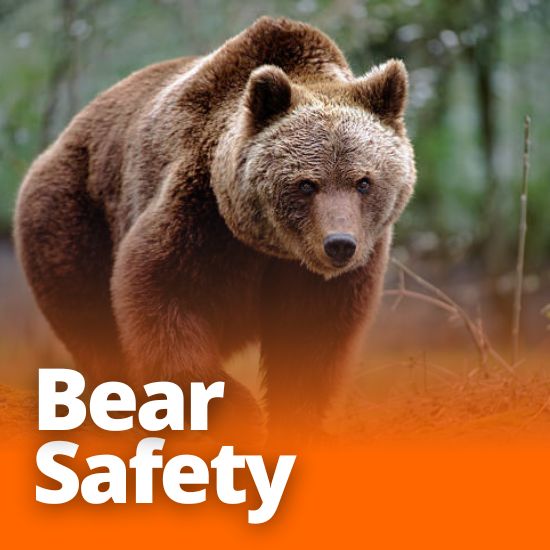
“Whoa Bear!” Bear Safety in Canada
I don’t know if it was just me, but as a child I was taught that in order to protect yourself from a bear attack you were to make yourself big and yell “whoa bear!” at the animal – like it’s somehow going to spontaneously understand English. (was I taught by Dr. Dolittle?…things to research in the future…)
Just like taking a dip in the ocean, going out into the wilderness you are entering the home of a much larger and dangerous animal, and therefore you need to respect that when heading out on the trail. However, you are more likely to get struck by lightning than you are to get attacked by a bear (or a shark)!
Lightning strike: 1 in 15,300
Shark attack: 1 in 3,748,067
Bear attack: 1 in 2.1 million
The key to safety in anything is knowledge. Knowledge is power! If you’re unfamiliar with these animals, having a little bit of extra info can help ease your anxieties:
- Bears prefer to avoid people
- Humans are NOT on the menu. A bear’s primary diet is actually vegetarian
- The vast majority of bear encounters are a positive experience
- There are proactive ways to avoid encountering a bear
- When used properly, bear spray is extremely effective
- Bears are actually not ferocious animals, and can be described as more shy creatures.
Canada has several species of bears in its borders, here are the ones you’re most likely to come across if you do.
- Black bears are the most commonly seen bear in Canada, living in every province and territory
- Grizzly bears or brown bears are found in Northwestern Canada, mostly located in the coastal and mountain regions of British Columbia, Alberta, and the Yukon
- The Kermode bear, also called the ‘spirit bear’ is a famous subspecies of black bear with beautiful white fur (they are not albino!) They can be found around the northern and central coast region of British Columbia
- The polar bear; two thirds of the world’s polar bear population is actually found in the northern, ice-covered regions of Canada
This article will concentrate on bear safety concerning black and grizzly bears, as they are the two you are most likely to encounter in Canada.
While we’re often taught that black bears and grizzlies are easy to distinguish, it’s not always as simple as size or color. For example, an adult black bear can appear a lot larger than an adolescent grizzly. Both variants of bears also come in a variety of colors from a blonde to very dark brown/black fur.
Grizzly or black bear?
Some of the best ways to distinguish these bears is by habitat and more specific distinguishing features:

Black Bears
| Grizzly Bears
|
Regardless, both have similar diets consisting of plants, berries, and insects – but will be drawn to you if they smell food as they are opportunistic feeders; they’ve been known to eat carrion!
So how do you avoid a negative bear encounter?
Again: knowledge, knowledge, knowledge!
- Research your destination. Learn about the local wildlife. Check for any restrictions or recommended safety precautions, particularly in seasons when animals will have young with them
- Read and follow all trailhead signage. Respect trail closures and wildlife warnings, they have been put in place for a reason.
- Make noise (more info on this below)
- Remain alert at all times. Watch for fresh bear signs like tracks, digging, and scat, and do not wear headphones or earbuds on the trail.
- Stay on the trail and travel during the day. Bears and many other predatory animals are most active at dawn and dusk
- Avoid animal carcasses. Wildlife, bears included, are attracted to dead animals
- Keep pets on a leash. Dogs can provoke defensive behavior in bears
- Pack out everything you bring with you, whether you’re in a tent in the backwoods or in a RV camp, include all garbage and biodegradable items such as apple cores and bananas peels when packing up for the day
- Travel in a group. The larger the group, the fewer recorded attacks
- Store food and garbage safely when camping. Bears are curious and will often act as scavengers, they will inspect odors to see if they’re edible
- Learn about bear behavior. Being able to interpret their postures and vocalizations can be incredibly helpful
- Know how to respond during an encounter or attack
- Carry bear spray.
Making Noise on the Trail:
Bears don’t want to meet you anymore than you want to meet them. They have exceptional hearing and are believed to have come to associate voices to human presence and will generally avoid you.
- Wild animals actually don’t want to be near humans, the number one tip to avoiding negative encounters is to simply be obnoxiously human
- This means talking or singing loudly, which can feel a little silly at first, but it is a tried-and-true method for avoiding bear encounters
- Get louder when it may be more difficult to hear or when sound may not carry as easily (on windy days or close to streams and dense vegetation)
- It’s an especially good idea to be vocal in areas with low visibility. Don’t surprise a bear when coming around a blind corner! (It’s a myth that bears can’t see well but they can be unaware of their surroundings and can literally stumble across a human)
Parks Canada does NOT recommend the use of bear bells. They are not considered an effective means of communicating human presence to animals. It’s more likely the sound will be associated with natural background noise, like birds, insects, or water.
Bear Spray: This is an aerosol deterrent typically made with chili pepper oil, it’s designed to be deployed within a close range (typically less than 10 meters) and should be done so in the face of an aggressive or charging bear. Much like pepper spray carried by police, it causes the eyes, nose, and lungs of an animal to swell and will restrict sight and breathing.
It should be used as a last resort tool in order to get away from an attacking bear. Make sure you have familiarized yourself with your particular canister. Most often it is stated for you to use the entire can at once, which will fully deplete in 7-9 seconds depending on the can. Make sure you keep it within easy reach, such as in a holster on your hip. The key is fast deployment. If in a group it’s recommended everyone who is able has one on hand. There is no such thing as over-preparedness.
So what do you do if you see a bear?
In 1979, to capture some of the audience inspired by Spielberg’s Jaws, a movie about a killer grizzly bear was released, aptly title Grizzly. It was…bad. But, much like Jaws did to sharks, the idea of bear attacks became a lot more universal. Unfortunately, mostly due to Hollywood dramatics, we have several patently untrue ideas about what to do during a bear encounter.
What you should never do:
- Run; this may cause the bear to pursue you
- Drop your bag – backpacks, hiking poles and other equipment can be used in defense if necessary
- Scream; speaking firmly and calmly will indicate you are not a prey animal
- Make sudden or jerky movements
- Turn your back on the animal(s)
- Block the bear’s escape route or corner it.
What you should do:
- Stop
- Stay calm
- Have your bear spray ready (in hand, cap off). Take note of wind direction and strength
- When in a group, stay together. Pick up small children and do not stray from the pack.
- Move away from the animal slowly and steadily.
- Assess the bear’s behavior to try and determine if it is going to approach you and why
Most of the time you’ll come across a bear in the distance, in these cases:
- Do not approach
- Give the animal space
- If the animal is moving, wait for it to pass from a safe distance
- If you are able, make a wide detour around the bear
- Move slowly to avoid its attention
- Be prepared to turn around and go back the way you came.
A bear at a distance is less likely to react with aggression than one in close proximity. If a bear is surprised or has cubs, they are likely to react defensively. Signs to watch for that display agitation are: swatting the ground or snorting.
A non-defensive bear may be curious and searching for human food, testing its dominance, or in rare cases, predatory. Signs of this will be: the bear’s attention being directly on you with its head and ears up. It may also stand on its hind legs; this is not a sign of aggression but of curiosity as it attempts to identify you.
An interesting note: unlike wolves, bears are not territorial creatures! They’ll share ranges with other bears, this mutual use of land and resources is a basis for their social behavior.
In the case of a defensive bear:
- Remain still and calm
- Talk in a slow, soothing voice; remember, bears have been shown to associate voices with humans making you something it may not want to approach
- Start backing away while avoiding eye contact
- If the bear does start to approach hold your ground and prepare your bear spray
- In the case the bear makes contact with you: drop to the ground and play dead. Lay on your stomach with your legs spread while covering your neck and the back of your head with your hands. Having your legs spread makes it harder for the bear to roll you over and get at your belly.
- Most defensive attacks will last two minutes or less. Remain still afterwards and wait for the bear to leave
- If the attack doesn’t stop fight back
In the case of a non-defensive/aggressive bear:
- Remain calm
- Talk in a firm voice (like reprimanding a kid or dog) You don’t want to appear as prey
- Move out of the bear’s way
- If the bear follows, stand your ground and switch to more aggressive behavior
- Look the bear in the eye, shout, stamp your feet, make yourself look bigger by spreading your arms, take a step towards it
- If the bear approaches you, use bear spray and fight back
- Concentrate your attack on the bear’s face, nose and eyes specifically. Punch and claw as hard as you can, use whatever is in reach as a weapon: rocks, hiking poles, heavy water bottles, etc.
However, the key to preventing a bear attack is to avoid bears as much as possible. Avoid inviting bears and other animals to your campsite by following appropriate food storage safety tips, keeping your campsite clean, and not leaving any pets or small children unattended.
(information from: Alberta Parks, BearSmart, Parks Canada)
